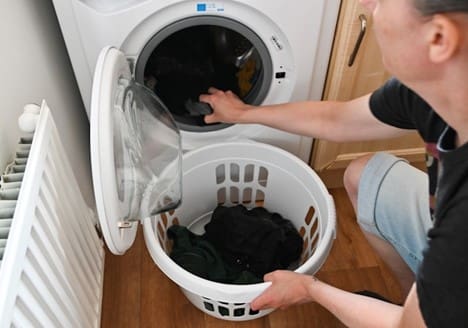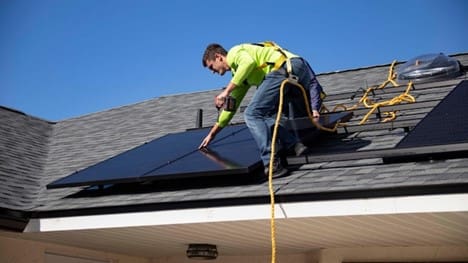As more homeowners become conscious of the environment and rising utility costs, energy-efficient homes have surged in popularity. When building new, incorporating energy-efficient features is an investment that can pay off in reduced energy consumption, lower utility bills, and a more sustainable living environment. Below are the top 10 energy-efficient features to consider for new construction homes in Maine.
Solar Panels
One of the most impactful energy-efficient features your general contractor can add to your new home is solar panels. Solar energy is a renewable resource that harnesses the power of the sun to generate electricity, significantly reducing reliance on traditional energy sources. Solar panels can help lower monthly electricity bills and, in some cases, generate enough power to sell back to the grid. By installing solar panels, you’re not only reducing your carbon footprint but also increasing your home’s long-term value and sustainability.
Smart Thermostats
Gone are the days of manually adjusting the thermostat. Smart thermostats are a game-changer when it comes to energy efficiency. These devices learn your schedule and adjust the temperature in your home accordingly, ensuring your heating and cooling systems are running efficiently. You can also control smart thermostats remotely using your smartphone, which means you can turn off your HVAC system while you’re away, further reducing energy consumption. Some models even have sensors that detect whether someone is home, adjusting the temperature based on occupancy, further optimizing energy use.
High-Performance Insulation
Effective insulation is key to maintaining a comfortable home while reducing the need for constant heating and cooling. High-performance insulation—such as spray foam, fiberglass, or cellulose—helps to keep warm air inside during the winter and cool air inside during the summer. Proper insulation reduces the workload on your HVAC system and helps maintain consistent indoor temperatures, which can lead to significant savings on energy bills. Insulating key areas like the attic, walls, floors, and basement is crucial to improving a home’s energy efficiency.
Energy-Efficient Windows
Windows are one of the largest sources of heat loss or gain in a home. Installing energy-efficient windows, such as double or triple-glazed windows with low-emissivity (Low-E) coatings, can drastically reduce energy loss. These windows minimize heat transfer between the inside of the house and the outside environment, keeping your home cooler in the summer and warmer in the winter. Energy-efficient windows can also reduce outdoor noise, increase comfort, and protect your furniture from sun damage caused by UV rays.
LED Lighting
Swapping out traditional incandescent light bulbs for LED lighting is one of the easiest and most cost-effective ways to improve a home’s energy efficiency. LEDs use up to 75% less energy than incandescent bulbs and last up to 25 times longer. These long-lasting bulbs not only reduce energy consumption but also lower the frequency of bulb replacements, reducing waste. In addition to being energy-efficient, LED lights are available in various colors and styles, making it easy to incorporate them into your home’s design.
Energy-Efficient Appliances
When building a new home, selecting energy-efficient appliances should be a top priority. Look for products that have the ENERGY STAR label, which indicates that they meet stringent energy efficiency standards set by the U.S. Environmental Protection Agency (EPA). ENERGY STAR-rated appliances—such as refrigerators, washing machines, dishwashers, and water heaters—consume significantly less energy than standard models, helping homeowners save on utility bills while reducing their environmental impact.

Tankless Water Heaters
Traditional water heaters store large amounts of water and continuously heat it, even when it’s not being used. Tankless water heaters, also known as on-demand water heaters, heat water only when it is needed, eliminating standby heat loss and reducing energy consumption. By providing hot water on-demand, tankless water heaters are more efficient and can save homeowners money on their energy bills in the long run. They also take up less space than traditional water heaters, which can be a benefit for homes with limited storage.
Cool Roofs
A cool roof is designed to reflect more sunlight and absorb less heat than a standard roof. By installing a cool roof, you can reduce the amount of heat that enters your home, which in turn reduces the need for air conditioning. Cool roofs are particularly beneficial in warm climates, where cooling costs can account for a significant portion of a home’s energy consumption. These roofs are available in a variety of materials, including reflective shingles, tiles, and coatings, and can greatly improve the overall energy efficiency of your home.
Energy-Efficient HVAC Systems
An energy-efficient heating, ventilation, and air conditioning (HVAC) system is crucial for maintaining a comfortable home while keeping energy costs low. Look for HVAC systems with high Seasonal Energy Efficiency Ratios (SEER) ratings, which indicate greater efficiency. A variable-speed HVAC system can also help optimize comfort and energy use by adjusting airflow based on the current temperature, minimizing energy waste. Regular maintenance, including filter changes and system inspections, is also key to ensuring your HVAC system runs efficiently for years to come.
Rainwater Harvesting Systems
Rainwater harvesting systems collect and store rainwater for use in irrigation, landscaping, or even household tasks like washing clothes or flushing toilets. By capturing rainwater, homeowners can reduce their reliance on municipal water systems and lower water bills. These systems also help conserve potable water and reduce the strain on local water resources. Incorporating a rainwater harvesting system in your new home construction is an eco-friendly option that can enhance overall sustainability and reduce your home’s environmental impact.
Conclusion
Building an energy-efficient home not only supports environmental sustainability but also offers significant long-term savings for homeowners. By incorporating features such as solar panels, smart thermostats, high-performance insulation, and energy-efficient appliances into your new home construction, you can reduce energy consumption, lower utility bills, and create a more comfortable living space. As energy efficiency becomes an increasingly important priority, these features are no longer just a trend—they represent a smart investment in the future of both your home and the planet. Working with experienced building contractors in Maine can help ensure these energy-saving solutions are seamlessly integrated into your home design.


